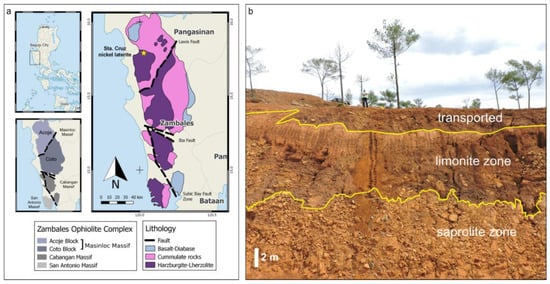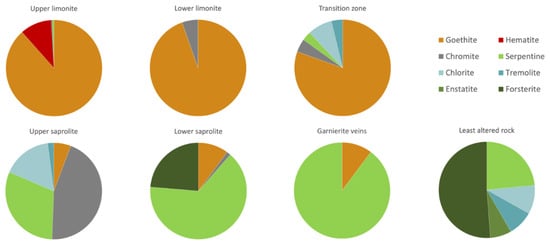Your browser does not fully support modern features. Please upgrade for a smoother experience.
Please note this is a comparison between Version 2 by Conner Chen and Version 4 by Conner Chen.
Tectonic emplacement of variably serpentinized ultramafic host rock on land and subsequent chemical weathering under humid tropical to subtropical conditions results in the formation of nickel laterite deposits. Nickel laterites typically occur as weathering mantle over ophiolite complexes, as well as komatiites and layered complexes in Archean to Phanerozoic stable cratonic platforms.
- nickel laterites
- limonite
- saprolite
- serpentinite
- garnierite
- ophiolite
1. Introduction
Tectonic emplacement of variably serpentinized ultramafic host rock on land and subsequent chemical weathering under humid tropical to subtropical conditions results in the formation of nickel laterite deposits [1][2][3][4][5][6][7]. Nickel laterites typically occur as weathering mantle over ophiolite complexes, as well as komatiites and layered complexes in Archean to Phanerozoic stable cratonic platforms [2][5]. Nickel laterite deposits have a characteristic profile (from the bottom to the top): (1) bedrock consisting of partially altered ultramafics; (2) a silicate or saprolite zone characterized by Mg-silicates, such as serpentine and garnierite; and (3) an oxide or limonite zone, predominantly composed of iron oxyhydroxides, principally goethite, hematite, and maghemite [1][2][3][4][5][6]. Garnierite is a general term for a distinctively green, neoformed, fined-grained, and poorly crystalline mixture of one or more Mg-Ni phyllosilicates including serpentine, talc, chlorite, smectite, and/or sepiolite [8][9][10][11][12][13]. The term “garnierite” has been used as a field term to describe this mineral assemblage in the absence of a more detailed mineral identification. Garnierites have been classified into two groups: (a) 1:1 phyllosilicate or serpentine group and (b) 2:1 phyllosilicate group (e.g., talc, kerolite, chlorite, and sepiolite) [10][13]. They are Ni-rich and typically occur as veins along joints and shear zones, as matrix within breccias, and as coatings on saprolite blocks [4][5][14][15][16][17].
An earlier study [18] emphasizes the primary role of “goethite ageing” with the downward decrease in the bulk Ni content within the limonite of lateritic ores from New Caledonia. Goethite ageing refers to the upward increase in crystallinity of goethite within the limonite zone resulting from the expulsion of Ni from the crystal structure of goethite. Nickel is then either leached from the limonite or is sorbed on the surface of goethite crystals. This is supported by previous works [19][20] that observed a decrease in the crystallinity of goethite with increasing depth. These results suggest that as the nickel laterite profile evolves, goethite crystallinity increases, and nickel content decreases upward through the profile. Goethite ageing is therefore an important aspect of the evolution of the nickel laterite profile.
2. Zambales Ophiolite Complex
The Zambales ophiolite complex (ZOC), located in Zambales, Philippines (Figure 1a), is a generally north–south trending, east dipping complete ophiolite suite comprised of a succession of volcanic rocks, dike-sill complexes, ultramafic and mafic cumulates, residual harzburgite, and lherzolites [21][22][23][24]. The ZOC is subdivided into three massifs from north to south: the Masinloc, Cabangan, and San Antonio massifs, with each massif separated by west-northwest fault boundaries [25][26]. The Masinloc massif is made up of two blocks: the Acoje block in the north and the Coto block in the south. The Acoje block and the San Antonio massif are compositionally similar, having an island arc tholeiite (IAT) affinity, whereas the Coto block and the Cabangan massif have a signature transitional from a mid-ocean ridge basalt to island arc (MORB-IA) [22][26]. The ZOC has been dated Eocene based on the fossil assemblage of the overlying Aksitero formation [27][28]. Direct radiometric dating of various units from the ZOC concurs with the Late Eocene age of the Aksitero formation and yielded a Middle Eocene age for the ophiolite [29][30]. Schweller et al. [31] suggest an early Miocene eastward tilting and erosion of the ZOC, likely related to the subduction initiation along the ancestral Manila Trench. The Eocene age of the ophiolite implies that it is 10–15 Ma years older than the South China Sea (SCS) crust [32], suggesting that it cannot originate from the SCS [29].


Figure 1. (a) Location of the study area. The Zambales Ophiolite Complex is in west Central Luzon, Philippines. It is subdivided into three massifs—the Masinloc, Cabangan, and San Antonio Massifs—separated by west–northwest fault boundaries. The Masinloc massif is subdivided into the Acoje and Coto blocks. Yellow star indicates the location of the Sta. Cruz nickel laterite deposit. (b) Photo of the nickel laterite profile investigated. The saprolite zone is overlain by the limonite zone. The topmost unit is a mechanically transported layer and is therefore not sampled for this study. Modified from Aquino et al. [33].
3. Sta. Cruz Nickel Laterite Deposit
The Sta. Cruz nickel laterite deposit formed from the weathering of the ultramafic massif of the ZOC Acoje block (Figure 1). The selected nickel laterite profile is located in the municipality of Santa Cruz, northern Zambales. The deposit exhibits a typical laterite zonation, consisting of an upper limonite layer, which is underlain by the saprolite layer and bedrock. Nickel mineralization in the deposit is associated with the low-Ni, high-Fe limonite zone and the more extensive low-Fe, high-Ni saprolite zone [34]. The underlying bedrock is harzburgite with sporadic dunite lenses and minor chromitite. The harzburgite is partly serpentinized, with olivine replaced by serpentine pseudomorphs, but the grain shape has been retained. Orthopyroxene, on the other hand, is partly replaced by talc and chlorite [22].
The nickel laterite profile investigated (Figure 1b) is approximately 12 m high and composed of two main units—an upper limonite zone (~7 m) and a lower saprolite zone (~5 m)—as well as a thin transitional zone (~10 cm), each characterized by a distinct set of physical, mineralogical, and geochemical properties. The detailed mineralogy of this outcrop can be found elsewhere [33][35] and is summarized in Figure 2.


Figure 2. The laterite profile is subdivided into five subzones based on the mineralogy. The topmost zone is the upper limonite subzone, dominated by goethite with minor hematite, and is underlain by the lower limonite subzone composed of goethite and minor chromite. The transition to the saprolite is marked by the first appearance of silicate minerals and a decrease in goethite abundance. The saprolite zone is marked by the dominance of Mg-silicates and a decrease in the abundance of goethite. The upper saprolite subzone is comprised mostly of serpentine, with minor chlorite and tremolite. The lower saprolite subzone is distinguished by the presence of relict olivine. The sample taken at a depth of 10.5 m represents the least altered rock in the profile. This sample is moderately serpentinized (~40%) and has significant primary minerals. Lastly, garnierite veins are composed of about 90 wt% serpentine and 10 wt% goethite. Note that abundant chromite of primary origin was observed in the upper saprolite zone. Data are obtained from Aquino et al. [33].
